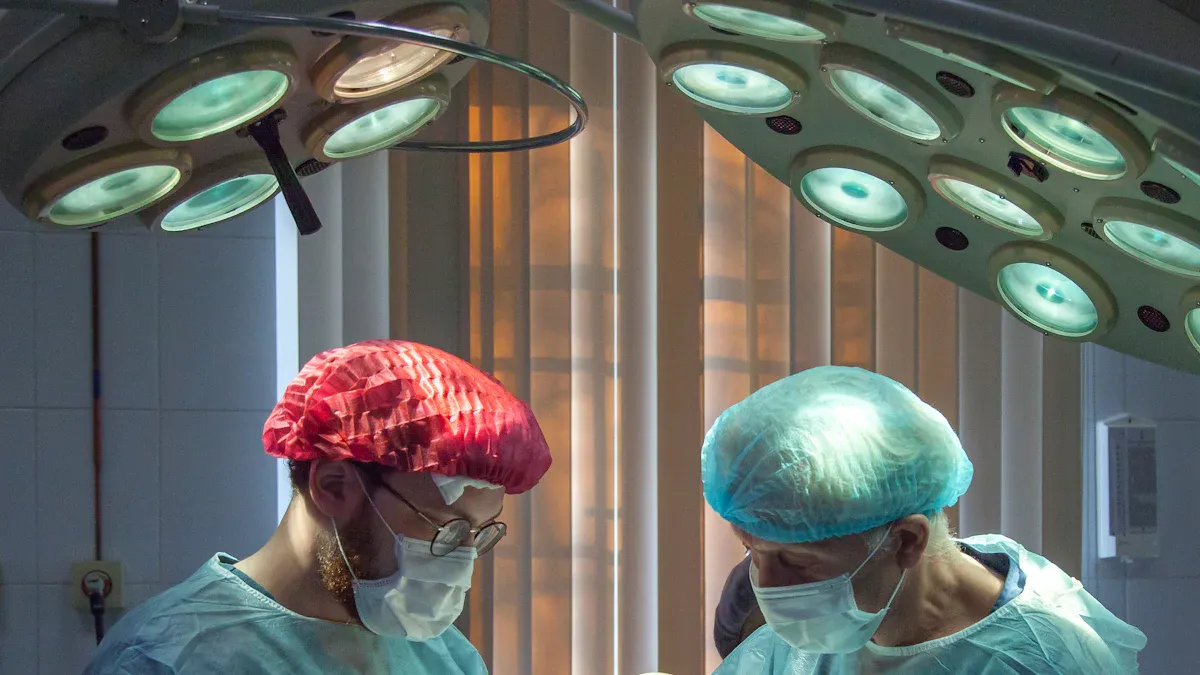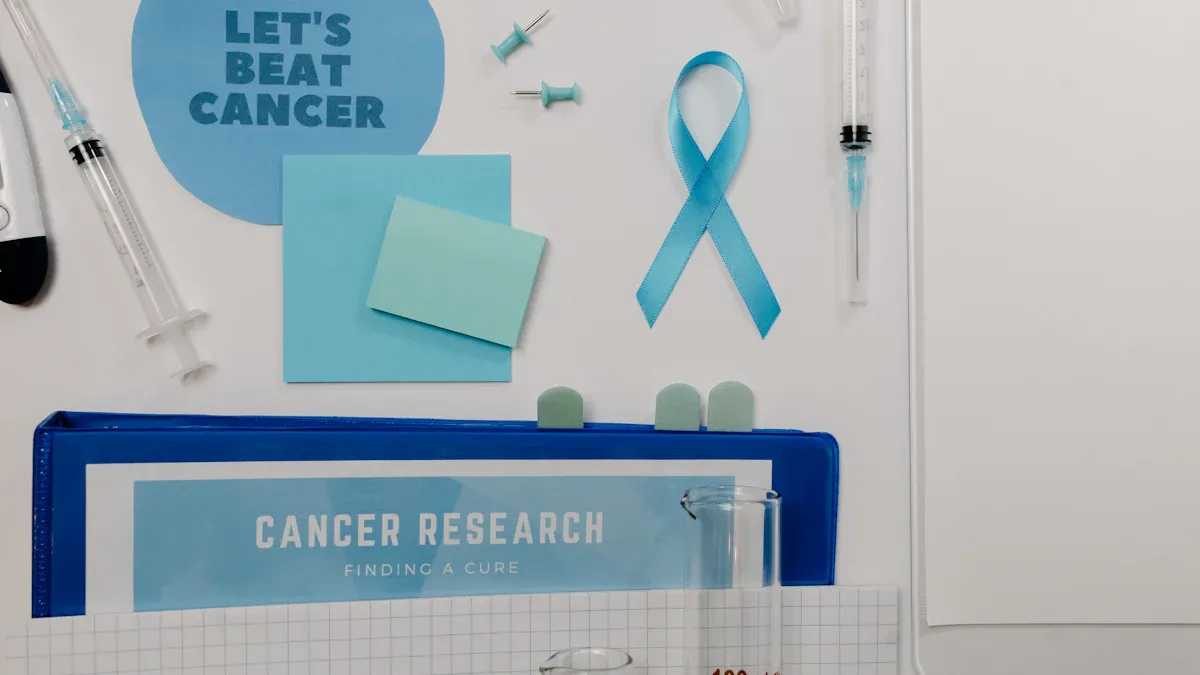Training Healthcare Providers in Cancer Risk Made Simple

Training healthcare providers in cancer risk assessments plays a vital role in improving early detection and patient outcomes. You need a structured approach to build confidence and competence in this critical area. Studies show that structured programs significantly enhance provider knowledge, communication skills, and practical abilities. Participants in these programs report higher self-confidence and improved teamwork, which directly impacts patient care. Equipping providers with the right tools, education, and ongoing support ensures they can assess risks effectively and guide patients toward better health decisions.
Key Takeaways
Planned training helps healthcare workers learn and feel confident about cancer risks.
Knowing genes, habits, and surroundings is key to checking cancer risks well.
Using tools like QCancer and CRISP helps make better choices for patients.
Talking clearly with patients about cancer risks builds trust and helps them choose wisely.
Learning more through classes and online lessons keeps healthcare workers skilled in cancer care.
Understanding Cancer Risk Assessments

What Are Cancer Risk Assessments?
Definition and purpose in healthcare.
Cancer risk assessments are tools and processes that help you evaluate a patient’s likelihood of developing cancer. These assessments rely on a combination of genetic, environmental, and lifestyle factors to provide a comprehensive understanding of risk. Their primary purpose is to guide healthcare providers in identifying individuals who may benefit from further testing, preventive measures, or personalized care plans.
The findings from studies show that these tools improve clinical judgment and help detect cancer symptoms early. By defining their purpose clearly, you can enhance patient outcomes and make more reliable decisions in your practice.
Role in early detection, prevention, and personalized care.
Cancer risk assessments play a critical role in early detection. Many patients may not exhibit symptoms that lead to a quick diagnosis. These tools, such as QCancer and YourDiseaseRisk, help you identify risks even when symptoms are subtle or absent. Early detection allows you to intervene sooner, improving the chances of successful treatment.
In addition to early detection, these assessments support prevention by identifying modifiable risk factors. For example, you can use them to guide patients in making lifestyle changes, such as quitting smoking or improving their diet. They also enable personalized care by tailoring prevention and treatment strategies to each patient’s unique risk profile.
Why Are They Essential for Healthcare Providers?
Impact on patient outcomes and decision-making.
Cancer risk assessments significantly impact patient outcomes by enhancing your ability to make informed decisions. Tools like CRISP and QCancer improve your understanding of risk factors and symptoms, enabling timely diagnosis and treatment. Research highlights their role in refining the problem-solving process, which leads to better medical decision-making. However, these tools require adequate training to maximize their effectiveness in your practice.
Importance of addressing hereditary and lifestyle risk factors.
Understanding hereditary and lifestyle risk factors is essential for providing comprehensive care. Genetic predispositions, such as BRCA mutations, can increase a patient’s cancer risk. By identifying these factors, you can recommend genetic counseling or preventive measures. Lifestyle factors, including smoking, diet, and physical activity, also play a significant role. Addressing these risks empowers you to guide patients toward healthier choices, reducing their overall cancer risk.
🩺 Tip: Incorporating cancer risk assessments into your routine practice can help you deliver more precise and effective care.
Core Components of Training Healthcare Providers in Cancer Risk Assessments
Comprehensive Education on Cancer Risk Factors
Genetic predispositions, family history, and hereditary risks.
Understanding genetic predispositions and hereditary risks is essential for effective cancer risk assessments. You need to recognize how genetic mutations, such as BRCA1 and BRCA2, influence cancer susceptibility. Family history plays a significant role as well. Patients with a strong family history of cancer may require genetic counseling or additional screening. Comprehensive education ensures you can identify these risks and recommend appropriate interventions.
Experiential learning and interprofessional education programs have proven effective in building this knowledge. These approaches help you gain confidence in areas outside your primary expertise. Studies show that participants retain this knowledge over the long term, enhancing their ability to assess hereditary risks accurately.
Psychosocial and environmental influences on cancer risk.
Cancer risk is not solely genetic. Psychosocial and environmental factors also contribute significantly. For example, excessive body weight, poor diet, and lack of exercise are often overlooked as carcinogenic factors. A study revealed that less than 27% of healthcare providers recognized these links. This highlights the need for targeted education on lifestyle and environmental risks.
By addressing these gaps, you can guide patients toward healthier choices. Educating patients about modifiable risks, such as smoking cessation or increasing physical activity, empowers them to take preventive actions.
Utilizing Risk Assessment Tools Effectively
Overview of widely used tools and software.
Cancer risk assessment tools, like QCancer and CRISP, help you estimate a patient’s likelihood of developing cancer. These tools analyze genetic, lifestyle, and environmental data to provide risk scores. They assist you in deciding who requires further testing or preventive measures. However, some tools face challenges, such as skepticism about their efficacy and the need for more consultation time. Understanding these limitations ensures you use them effectively.
Interpreting risk scores and integrating data into practice.
Interpreting risk scores requires a clear understanding of the data. You must analyze the results and integrate them into your clinical decisions. This process involves identifying high-risk patients and tailoring care plans to their needs. Training programs that include simulation-based learning can enhance your ability to interpret and apply these scores. These programs improve your problem-solving skills and ensure you can make informed decisions.
Communicating Cancer Risk to Patients
Best practices for clear, empathetic communication.
Effective communication is crucial when discussing cancer risk with patients. You should use clear language and visual aids to explain complex information. Studies show that combining bar graphs and frequency diagrams improves patients’ understanding of their risk. This approach is especially helpful for those who initially misperceive their risk.
Empathy is equally important. Patients may feel anxious or overwhelmed when learning about their cancer risk. By listening to their concerns and addressing them with compassion, you can build trust and encourage open dialogue.
Addressing patient concerns and supporting decision-making.
Patients often have questions about their risk and the next steps. Your role is to provide accurate information and support their decision-making process. Using multiple communication strategies, such as numerical data and visual aids, enhances comprehension. This approach leads to better patient outcomes, including faster diagnosis and treatment. Encouraging patients to participate in their care fosters a sense of empowerment and improves their overall experience.
🩺 Tip: Regularly practicing communication techniques can help you convey cancer risk information more effectively.
Step-by-Step Training Process for Cancer Risk Assessments
Initial Education and Knowledge Building
Incorporating cancer risk assessment into medical training.
Integrating cancer risk assessment into medical training is essential for preparing you to address this critical aspect of patient care. Studies reveal that only 28.13% of medical residents receive professional training in cancer prevention and screening. This highlights a significant gap in education. Current curricula often focus on diagnosing and treating diseases, leaving limited room for systematic cancer screening. By incorporating cancer risk assessment principles into training, you can enhance your ability to make public health recommendations and contribute to cancer prevention efforts.
🩺 Note: Enhancing your cancer literacy early in your career equips you to provide better preventive care and improve patient outcomes.
Providing foundational knowledge on genetics and risk factors.
A strong foundation in genetics and risk factors is vital for effective cancer risk assessments. You need to understand how genetic mutations, such as BRCA1 and BRCA2, influence cancer susceptibility. Additionally, recognizing lifestyle and environmental factors, like smoking or diet, helps you identify modifiable risks. Comprehensive education ensures you can assess these risks accurately and recommend appropriate interventions.
Hands-On Practice and Skill Development
Role-playing, case studies, and interactive simulations.
Hands-on practice methods, such as role-playing and case studies, significantly enhance your skills. For example, a study by Papadakos et al. showed that using standardized patient actors for role-playing improved empathy and communication in oncology care. Similarly, Starks et al. found that reflective practice with simulated and real patients helped participants apply theoretical knowledge effectively. These methods allow you to practice in a safe environment, building confidence and competence.
Study | Methodology | Outcomes |
|---|---|---|
Papadakos et al. | Standardized patient actors for role-playing | Enhanced empathy and communication skills |
Starks et al. | Reflective practice with simulations | Improved application of theoretical knowledge |
Aebersold et al. | Oncology training for nurses and pharmacists | Improved cancer drug safety through evaluations |
Supervised practice with real-world scenarios.
Supervised practice bridges the gap between theory and real-world application. Working with experienced mentors allows you to refine your skills in actual clinical settings. This approach ensures you can handle complex cases and make informed decisions confidently.
Ongoing Evaluation and Continuous Learning
Regular assessments to ensure competency.
Regular evaluations play a crucial role in maintaining your competency. Studies show that after eight weeks of training, 92.8% of patients were assessed for hereditary cancer risk, demonstrating the effectiveness of continuous evaluation. Confidence assessments, such as pre- and post-module tests, help track your progress and identify areas for improvement.
Advanced training through workshops and certifications.
Workshops and certifications provide opportunities for advanced learning. These programs keep you updated on the latest tools and techniques in cancer risk assessments. By participating in these initiatives, you can stay ahead in your field and deliver high-quality care to your patients.
💡 Tip: Continuous learning ensures you remain confident and competent in assessing cancer risks throughout your career.
Tools and Resources for Training Healthcare Providers in Cancer Risk Assessments

Software and Digital Tools
Examples of effective cancer risk assessment tools.
Digital tools play a vital role in cancer risk assessment training. Tools like QCancer and CRISP help you evaluate a patient’s likelihood of developing cancer by analyzing genetic, lifestyle, and environmental data. These platforms streamline workflows, reduce cognitive overload, and improve decision-making. Participants in training programs often report that these tools enhance problem-solving and speed up diagnosis, especially for vague cancer symptoms. They also encourage open discussions with patients, improving education and engagement.
Evidence Description | Benefit of Digital Tools |
|---|---|
Integration of digital platforms assists PCPs in evaluating cancer risk | Streamlines workflows and reduces cognitive overload |
Enhances patient education and engagement | Improves patient outcomes |
Addresses unmet needs in cancer prevention guidelines | Facilitates better integration within primary care workflow |
Features to consider when selecting software.
When choosing a cancer risk assessment tool, you should prioritize user-friendly interfaces and compatibility with existing systems. Look for software that provides clear visualizations of risk scores and integrates seamlessly into your workflow. Tools offering patient education resources, such as visual aids or interactive modules, can further enhance communication. Additionally, ensure the software includes regular updates to align with the latest cancer prevention guidelines.
Educational Programs and Guidelines
Key resources from professional organizations.
Professional organizations offer valuable resources to support your training in cancer risk assessments. The American Cancer Society and the National Comprehensive Cancer Network provide evidence-based guidelines and educational materials. These resources help you stay informed about the latest advancements in cancer prevention and screening. Many organizations also offer workshops and webinars to enhance your practical skills.
Online courses, certifications, and continuing education options.
Online courses and certifications provide flexible learning opportunities. Interprofessional education (IPE) programs, for instance, significantly improve your knowledge, confidence, and practical skills. A systematic review found that 60% of participants implemented changes in clinical practice after attending IPE workshops. These programs also boost self-confidence and communication skills, enabling you to collaborate effectively with colleagues. By enrolling in these courses, you can stay updated and deliver high-quality care.
💡 Tip: Consider platforms offering self-paced learning to fit training into your busy schedule.
Overcoming Challenges in Training Healthcare Providers in Cancer Risk Assessments
Addressing Knowledge Gaps
Strategies for bridging gaps in foundational knowledge.
Bridging knowledge gaps requires a structured approach. You can use established frameworks like Kirkpatrick’s model and Moore’s outcome levels to evaluate training effectiveness. These frameworks assess learning outcomes and help tailor programs to meet diverse needs. Incorporating patient-reported outcomes and feedback mechanisms further enhances understanding and communication. For example, interprofessional education (IPE) programs in cancer care have proven effective in building foundational knowledge. They emphasize collaboration and patient-centered learning, ensuring you gain the skills needed to assess cancer risks accurately.
Tailoring training to different experience levels.
Healthcare providers have varying levels of expertise. Training programs should adapt to these differences. For beginners, foundational modules on genetics and lifestyle factors are essential. For experienced providers, advanced workshops focusing on complex case studies and emerging tools can deepen their expertise. A systematic evaluation approach ensures that all participants, regardless of experience, benefit from the training. This method fosters confidence and competence across the board.
Managing Time Constraints
Integrating training into busy healthcare schedules.
Time constraints often hinder training. To address this, you can integrate short, focused sessions into your daily schedule. Microlearning modules, which deliver content in small, manageable chunks, are particularly effective. These sessions allow you to learn without disrupting your workflow. Additionally, scheduling training during less busy periods or as part of team meetings can maximize participation.
Leveraging online and self-paced learning options.
Online training offers flexibility, making it easier to fit into your schedule. Self-paced courses allow you to learn at your convenience. Research supports this approach. For instance, a study by Pham et al. showed a 14% improvement in test scores weeks after completing an online program. Another study by Aebersold et al. highlighted substantial knowledge gains and high satisfaction among participants. These findings demonstrate the effectiveness of online learning in overcoming time constraints.
Study | Findings | Improvement |
|---|---|---|
Aebersold et al. | Substantial knowledge gains and high satisfaction | N/A |
Pham et al. | Average test score improvement maintained weeks later | 14% |
Ensuring Consistency and Quality
Standardizing training protocols and materials.
Consistency in training ensures quality. Standardized protocols and materials help you deliver uniform care. Developing clear guidelines and using evidence-based resources can streamline the process. For example, creating a centralized repository of training materials ensures all providers have access to the same information. This approach reduces variability and enhances reliability.
Monitoring and maintaining quality over time.
Regular monitoring is crucial for maintaining quality. You can use periodic assessments to evaluate your skills and identify areas for improvement. Feedback from patients and peers also provides valuable insights. Continuous updates to training materials ensure they align with the latest advancements in cancer care. By prioritizing quality, you can stay confident and competent in assessing cancer risks.
Challenge | Statistic |
|---|---|
Awareness of obesity as a carcinogenic factor | 23.44% |
Awareness of insufficient intake of fruits | 25% |
Awareness of lack of exercise | 26.56% |
💡 Tip: Regularly updating your knowledge and skills ensures you provide the best care possible.
Training healthcare providers in cancer risk assessments is essential for improving patient care and outcomes. Structured and continuous training enhances knowledge, confidence, and teamwork.
Description | |
|---|---|
Knowledge Gains | Significant improvements in understanding cancer risk assessment among healthcare providers. |
Increased Confidence | Enhanced self-assurance in assessing cancer risks post-training. |
Improved Interprofessional Collaboration | Better teamwork and communication among healthcare professionals in cancer care settings. |
Investing in advanced tools and resources further boosts provider competency. Tools like the Risk Assessment Tool (RAT) improve decision-making, expedite diagnoses, and promote patient education. They also encourage open discussions, helping patients understand their risks and take preventive actions.
💡 Tip: Prioritizing education, practice, and evaluation ensures providers stay confident and competent in delivering personalized care.
FAQ
What is the first step in learning cancer risk assessments?
Start by building foundational knowledge. Focus on understanding genetic predispositions, lifestyle factors, and environmental risks. Enroll in introductory courses or workshops that cover these topics. This step ensures you have a solid base to build advanced skills.
How can I integrate training into my busy schedule?
Use online, self-paced learning platforms. These allow you to study at your convenience without disrupting your workflow. Microlearning modules, which deliver content in short segments, are also effective for fitting training into tight schedules.
Are there specific tools I should use for cancer risk assessments?
Yes, tools like QCancer and CRISP are widely used. They analyze genetic, lifestyle, and environmental data to estimate cancer risk. Choose tools with user-friendly interfaces and compatibility with your existing systems for seamless integration.
How do I improve communication with patients about cancer risks?
Practice clear and empathetic communication. Use visual aids, such as graphs, to explain complex information. Listen to patient concerns and address them with compassion. Regularly practicing these techniques will enhance your ability to convey information effectively.
Is ongoing training necessary after initial education?
Yes, continuous learning is essential. Attend workshops, pursue certifications, and stay updated on the latest advancements in cancer risk assessments. Regular evaluations and advanced training ensure you remain confident and competent throughout your career.
💡 Tip: Make learning a lifelong habit to provide the best care for your patients.
See Also
An In-Depth Overview of Various Cancer Types
Recognizing Symptoms and Treatments for Duodenal Cancer
Identifying Symptoms and Treatment Options for Conjunctival Melanoma
